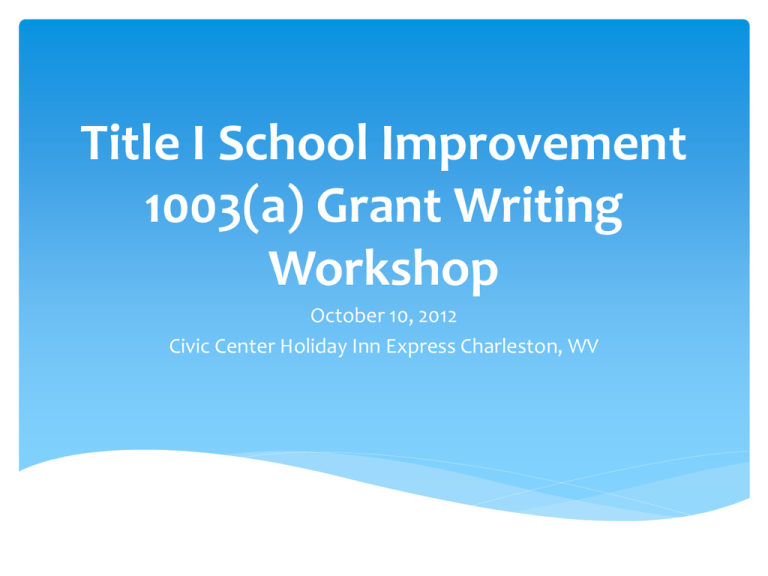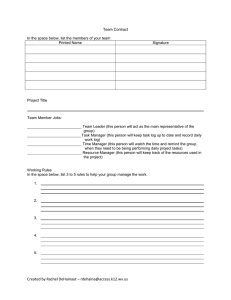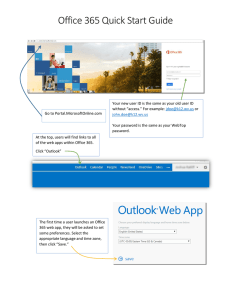Title I School Improvement 1003(a) Grant Writing Workshop October 10, 2012
advertisement

Title I School Improvement 1003(a) Grant Writing Workshop October 10, 2012 Civic Center Holiday Inn Express Charleston, WV Workshop Overview The workshop agenda follows the grant proposal format and provides guided group work time: Connection to Five Year Strategic Plan and 3 main focus areas of the grant Data analysis to determine need Proposal development (logic model & evaluation matrix) Submission and scoring information Reflecting and Connecting Teaching and Learning Clayton Burch, Office of Early Learning Improvement Processes Michele Blatt, Office of School Improvement Culture and Climate Don Chapman, Office of Healthy Schools Team Time How are the three main focus areas of this grant represented in your current Five Year Strategic Plan? Can you link these areas to existing plan content or do we need to add something? What accomplishments have we had in these areas over the past three years? What are our weaknesses in these three focus areas? Data Analysis Growth Data Sonya White, Office of Assessment Reflective Analysis and Root Causes Ryan Saxe, Office of Federal Programs Analyzing The Results – What’s Next? After reviewing and discussing current efforts and practices, the next step is to look at the results of student assessments to determine: To what extent is each student meeting the state performance targets in Reading/Math? To what extent is each student group represented on the AYP report meeting the targets? Are there patterns or trends? Do these patterns hold up over time? Why, despite all of our efforts and initiatives, are we not getting the results we want? What factors or conditions are getting in the way? How do we know? Dig Deeper – Determine Root Causes How do you know what factors or conditions are getting in the way? - After brainstorming the possible “root cause” issues, the team will need to differentiate between those that are unsubstantiated hunches and those that are not. - This analysis is important to assure that the issues selected as priorities for the plan can be supported with evidence. For example, if the “CHECK ENGINE” light remains on after starting a vehicle, is it because of a minor electronic malfunction or is it because of something else? The “CHECK ENGINE” light is just a symptom of a problem. “Digging deeper” will help the team discover the actual “root” of the problem. Determining Root Causes What is a “Root Cause”? In the “School Leader’s Guide to Root Cause Analysis: Using Data to Dissolve Problems”, Paul Preuss defines a root cause as “... the deepest underlying cause, or causes, of positive or negative symptoms within any process that, if dissolved, would result in elimination, or substantial reduction, of the symptom. Determining Root Causes What is a “Root Cause”? Priuses goes on to highlight key words: Deepest – this means that we need to look beyond the obvious and to continue to question and dig deeper into what we see. Cause or causes – education is a complex social system. As such the symptoms that we experience usually have more than one root cause that act in combination to bring about the results. “The good news is that often, by dissolving any one of the multiple root causes, the symptoms can be reduced or even eliminated” (p.4). Positive or negative – Root causes can be found for both failures as well as successes. Understanding successes can contribute to identifying effective strategies that may work to address negative symptoms. Symptoms – Symptoms are the “red flag” that draw attention to the gap between expected desired outcomes and the reality. Process – Everything we do involves process. At its most basic, a simple process consists of input, added value, and output. Dissolve – The purpose of root cause analysis is to identify the root cause(s) of a symptom, and, where the symptom is negative or undesirable, to find ways to dissolve the root rather than simply patching up and/or hiding the symptom. Team Time Analyze your data Based on the data available to you at this point, which of your needs should be addressed with this funding opportunity? Proposal Description Logic Model S.M.A.R.T. Objectives Evaluation Anduamlak Meharie, Office of Research Insert slides??? Team Time Teams will work through the application templates within the presentation segments LUNCH Strategic Plan Connections Connecting to your Five Year Strategic Plan Professional Development & Collaborative Teams Kathy Hypes, Office of Federal Programs Aligning the School Improvement Grant to the Strategic Plan PURPOSE OF GRANT The purpose of the SIG 1003(a) grant award is to support the goals as identified in each school’s five year strategic plan including addressing the specific subject area(s) and subgroup(s) causing the school to be identified for improvement. Aligning the School Improvement Grant to the Strategic Plan Elements of the Plan(Requirement for Title I) Consultation Core academic subjects Measurable goals and objectives Research based instructional strategies Sustained professional development Teacher-mentoring program Parental involvement Extended learning Technical Assistance from LEA and SEA Aligning the School Improvement Grant to the Strategic Plan Background Content Processes Student Support Culture and Climate Data Analysis key outcome indicators External Trends Student Achievement Other Student Outcomes Analysis of Culture, Conditions and Practices **Determination of root causes for identified deficiencies Aligning the School Improvement Grant to the Strategic Plan Goals and Objectives Goals are aligned with needs assessment and must align with State’s content standards and objectives. Objectives are written to target specific measurable outcomes related to goal and subgroups not making AYP. (Logic Model Development - grant) Strategies and Activities Action Steps (Logic Model Development –grant) Professional Development correlate to the goals and objectives *Sustained *Teacher-Mentoring Program Aligning the School Improvement Grant to the Strategic Plan Collaborative Teams Program Overview (#3) Professional Development Teacher Involvement (#9) Evaluation Title I Program Evaluation (#10) *Logic Model Development: Indicators to measure implementation, progress, and success (grant) *Evaluation Plan Matrix (grant) * Both will strengthen your strategic plan, revisit plan Aligning the School Improvement Grant to the Strategic Plan School’s Title I Budget Strategic Plan 1003 (a)Grant Proposal School Improvement 1003 (a) Grant Budget Other Grants and Budgets (i.e., Dance Grant) Budget, Submission and Scoring Budget Form and Budget Narrative Submission Requirements Scoring Rubric Grant Award Timelines Suzette Cook, Office of Federal Programs Budget Form TITLE I SCHOOL IMPROVEMENT 1003(a) GRANT FY13 BUDGET 5 Digit Program Function Code 3 Digit Object Code Description Amount from this School Improvement Grant *Amount from other Funding Sources (Specify Funding Source) Budget and Budget Narrative Budget Form may be replicated as needed Salaries and fixed costs must be itemized Budget Narrative Describe budgeted amounts that may be vague or unclear in the budget form (e.g., materials, supplies, professional development, technology, equipment, travel, etc.) Identify and explain budgeted amounts specified from other funding sources Submission Requirements Page 2 of the RFP At least a 12 pt. font - adhere to page limits for each section Pre-Submission Checklist Superintendent & county Title I director signatures for submission School team involvement in proposal development Electronic submission required by 4:00 pm, Friday, November 30, 2012 to eamccoy@access.k12.wv.us Scoring Rubric Background – 10 points Data Analysis and Statement of Need – 15 points Goals and S.M.A.R.T. Objectives – 15 points Strategies and Activities – 30 points Evaluation – 15 points Budget and Budget Narrative – 15 points Suzette Cook, Office of Federal Programs Grant Timeline Date Grant Process Sept. 10-Oct. 1, 2012 Collaborative Application Development Oct. 10, 2012 Grant workshop Oct. 29, 2012 TA Webinar @ 9:00 a.m. Nov. 26, 2012 Webinar training for Grant Readers Nov. 30, 2012 Application Submission Deadline Dec. 10, 2012 Grant Scoring Meeting Dec. 14, 2012 Selected grants submitted for WVDE approval Jan. 2, 2013 Finalize grant awards Q&A and Team Time This segment is reserved for team work time with access to various WVDE staff for questions and brainstorming. Good Luck… If you have questions as you are completing your application, contact your Title I county liaison: Robert Crawford – rcrawford@access.k12.wv.us Suzette Cook – scook@access.k12.wv.us Kathy Hypes – khypes@access.k12.wv.us Ryan Saxe – rsaxe@access.k12.wv.us Telephone for all: 304-558-7805 Hancock Title I Coordinator Assignments Brooke Ohio Effective September 2012 Marshall Wetzel Monongalia Morgan Marion Preston Tyler Pleasants Ritchie Wood Barbour Wirt Jackson Mason Gilmer Lewis Jefferson Tucker Hardy Upshur Braxton Randolph Pendleton Webster Clay Cabell Kanawha Nicholas Lincoln Boone Pocahontas Suzette Cook scook@access.k12.wv.us Fayette Greenbrier Mingo Hampshire Grant Calhoun Roane Putnam Wayne Berkeley Mineral Harrison Taylor Doddridge Logan Raleigh Summers Wyoming Kathy Hypes khypes@access.k12.wv.us Ryan Saxe rsaxe@access.k12.wv.us Monroe McDowell Mercer Robert Crawford rcrawford@access.k12.wv.us





